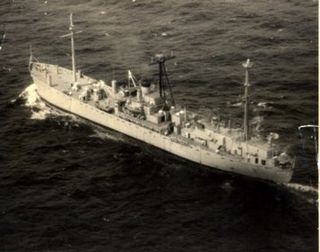This page is based on this
Wikipedia article Text is available under the
CC BY-SA 4.0 license; additional terms may apply.
Images, videos and audio are available under their respective licenses.

USS Liberty (AGTR-5) was a Belmont-class technical research ship that was attacked by Israel Defense Forces during the 1967 Six-Day War. She was originally built and served in World War II as a VC2-S-AP3 type Victory cargo ship named SS Simmons Victory. Her keel was laid down on 23 February 1945, under a Maritime Commission contract at Oregon Shipbuilding Corporation of Portland, Oregon.
USS Liberty may refer to:

USS Sampson (DDG-10), named for Admiral William T. Sampson USN (1840–1902), was a Charles F. Adams-class guided missile destroyer in the United States Navy.

William Loren McGonagle was a United States Naval officer who received the Medal of Honor for his actions while in command of the USS Liberty when it was attacked by Israel in the Eastern Mediterranean on June 8, 1967 during the Six-Day War.

USS Requin (SS/SSR/AGSS/IXSS-481), a Tench-class submarine, was the only ship of the United States Navy to be named after the requin, French for shark. Since 1990 it has been a museum ship at The Carnegie Science Center in Pittsburgh, Pennsylvania.

CSS Jamestown, originally a side-wheel, passenger steamer, was built at New York City in 1853, and seized at Richmond, Virginia in 1861 for the Virginia Navy during the early days of the American Civil War. She was commissioned by the Confederate States Navy (CSN) the following July, and renamed CSS Thomas Jefferson but was generally referred to as Jamestown, after Jamestown, Virginia.

Technical research ships were used by the United States Navy during the 1960s to gather intelligence by monitoring, recording and analyzing wireless electronic communications of nations in various parts of the world. At the time these ships were active, the mission of the ships was covert and discussion of the true mission was prohibited. The mission of the ships was publicly given as conducting research into atmospheric and communications phenomena. However, the true mission was more or less an open secret and the ships were commonly referred to as "spy ships".
166 is the natural number following 165 and preceding 167.

Alexander Gilmore Cattell was a United States Senator from New Jersey. Born in Salem, New Jersey, he received an academic education, and engaged in mercantile pursuits in Salem until 1846. He was elected to the New Jersey General Assembly in 1840, and served as clerk from 1842-1844. He was a member of the State constitutional convention in 1844 and moved to Philadelphia in 1846, where he engaged in business and banking. He was a member of the Philadelphia Common Council from 1848 to 1854, organized the Corn Exchange Bank, and was its president from 1858 to 1871. He moved to Merchantville, New Jersey in 1863 and was elected as a Republican to the U.S. Senate to succeed John P. Stockton, whose seat was declared vacant, and served from September 19, 1866, to March 3, 1871. He was not a candidate for reelection. While in the Senate, he was chairman of the Committee on the Library.

Henry Minett was a career officer of the United States Navy who served during the Spanish–American War. Prior to retirement in 1905, he achieved the rank of captain. He is best remembered as one of the early acting Governors of American Samoa. Minett Islet in Alaska is named for him.

USS Georgetown (AGTR-2/AG-165), was an Oxford-class technical research ship acquired by the U.S. Navy to provide a seaborne platform for global eavesdropping on behalf of the National Security Agency. Her designation as a "technical research" ship was her cover story.

USS Oxford (AGTR-1/AG-159) was an Oxford-class technical research ship, acquired by the U.S. Navy in 1960 and converted for the task of conducting "research in the reception of electromagnetic propagations". She was originally built during World War II as a Liberty-type cargo ship originally named the Samuel R. Aitken.

USS Jamestown (AGTR-3/AG-166) was an Oxford-class technical research ship acquired by the U.S. Navy for the task of "conducting research in the reception of electromagnetic propagations" (SIGINT).
USS Belmont is a name used more than once by the U.S. Navy:

USS Belmont (AGTR-4/AG-167) was a Belmont-class technical research ship, acquired by the U.S. Navy in 1963 and converted for the task of conducting "research in the reception of electromagnetic propagations". She was originally built during World War II as a Victory cargo ship named SS Iran Victory by the War Shipping Administration's Emergency Shipbuilding program under cognizance of the U.S. Maritime Commission.
George Parker Upshur was an officer in the United States Navy and the brother of Abel P. Upshur.
Edward Tatnall Nichols was a United States Navy rear admiral.

The Oxford class of technical research ships were a class of three World War II Liberty ships converted in the early 1960s to provide a seaborne platform for global eavesdropping on behalf of the National Security Agency. The ships of this class were similar to the Belmont-class ships of the same era with the difference being that they were adapted from Victory ships.














